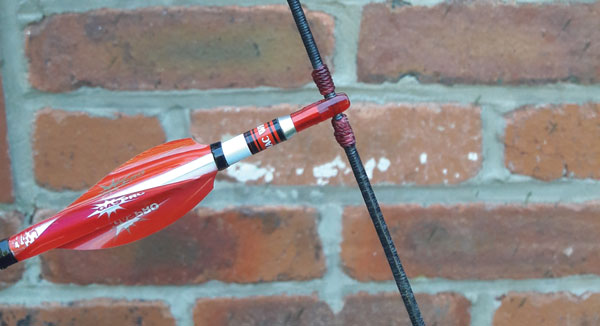Expert, Adrian Tippins, explains an often overlooked issue – how to know if your nocks fit correctly…
This is an often overlooked area in archery. The good news is that nock grooves only come in two sizes, small or large, known as #1 and #2 with some manufacturers such as Beiter. This gives us a simple choice, but the simplicity ends there. Nock fit can differ brand to brand, and even within the same brand depending on how precise the manufacturer’s moulding machinery is. It would also be an advantage if all bowstrings had the same central serving diameter, but this is another factor that shows up a bowstring’s individuality. Apart from being made from different materials, the strings will have differing strand counts, and different filament diameters. This is also true of the serving thread where the nock will connect to the string. Manufacturers use different brands, types and filament gauges. All these factors give us totally inconsistent nock to string fit.
Checking
To check for good nock fit the arrow should be able to hang vertically from the bowstring under it’s own weight without falling off. It should then detach itself when the string receives a light tap about two inches from the nock. This motion should be effortless and one in which the nock doesn’t pluck or twang the string. A nock that is too loose can be a danger to both bow and archer as they are prone to falling off at acute string angles, allowing the bow to dry fire. This might also make for a noisy shot as the bow’s energy isn’t being fully transmitted and absorbed by the arrow. If a nock is too tight on the string it will pluck the string on exit having used up too much of the bow’s energy to release it from the string. This will have adverse effects on arrow speed and sight marks.
Bear in mind
Additionally, you need to ensure that the nock isn’t pinched between the nocking points. There should be about a 1mm gap between the nock and top and bottom nocking points to allow for the string angle change at full draw. Never attempt to distort the shape of the nock or bend the ears in to try to alter the nock fit. The best solution is to have the string served in the correct gauge filament to fit the nock, or invest in custom strings to your own specification. Nocks that are potentially too loose for the string can be made to fit properly by applying a wind or two of dental floss between the nocking points. If small groove nocks are too tight, the only real solution is to change them for a large groove version.
Finally, your nock fit will alter over time as the nock chafes away at the serving between the nocking points. What once was fractionally too tight may become fine in time, and what was perfect may well become too loose. Periodical inspection is vital for the safe and efficient function of your equipment.
This article originally appeared in the issue 117 of Bow International magazine. For more great content like this, subscribe today at our secure online store www.myfavouritemagazines.co.uk


